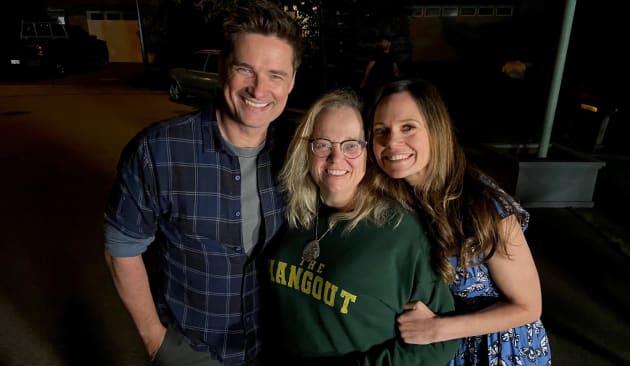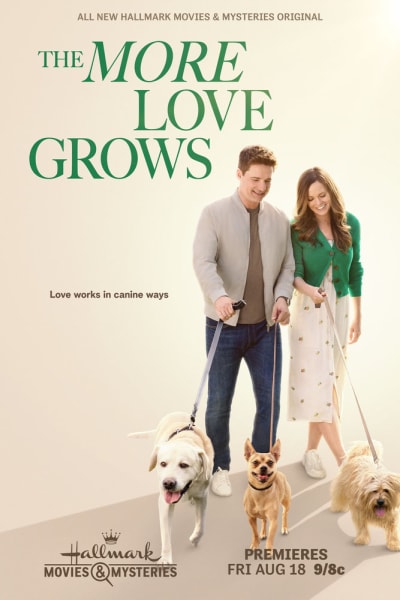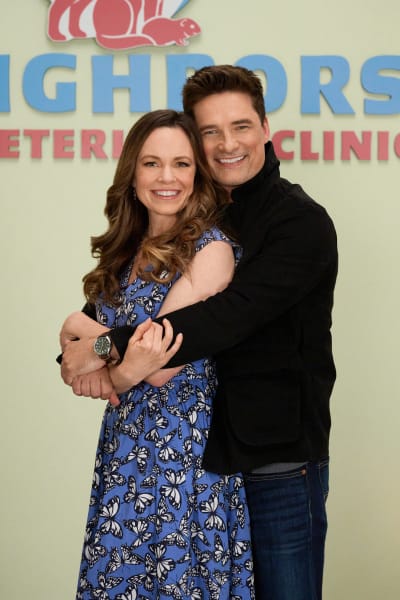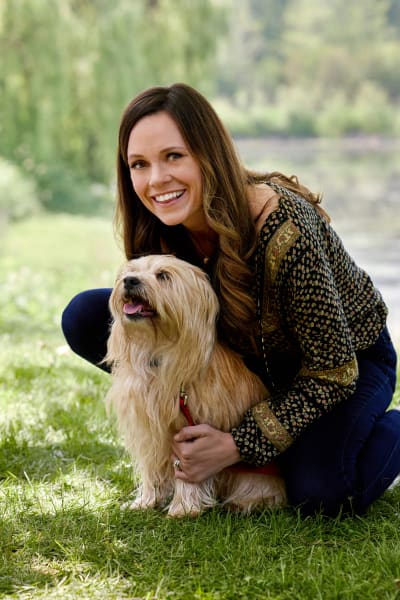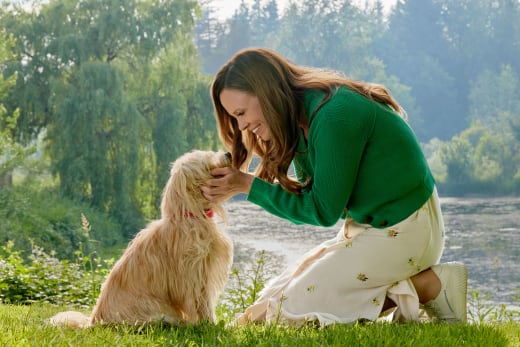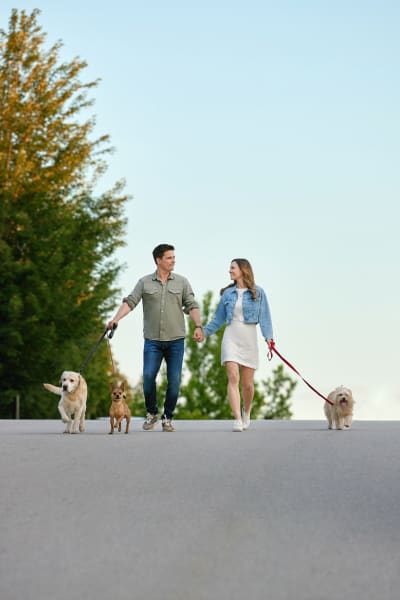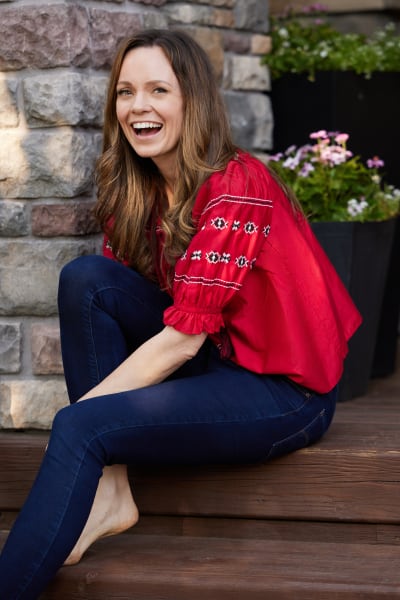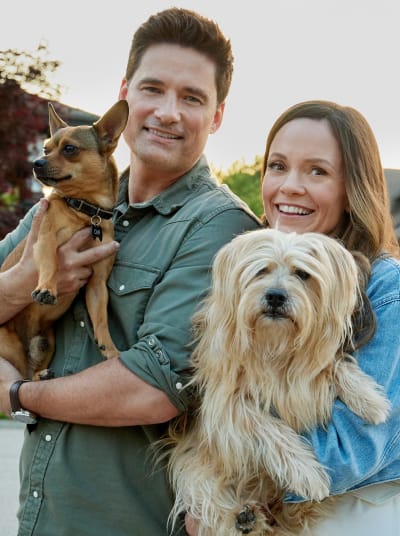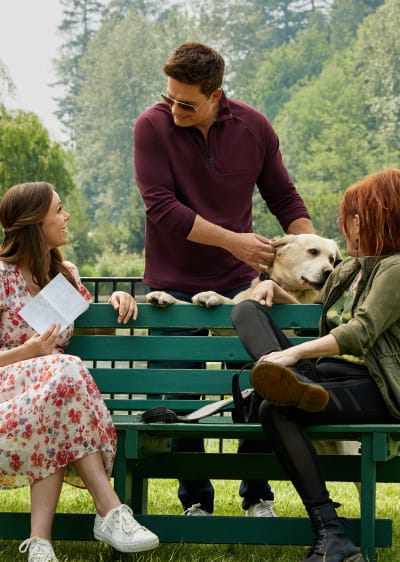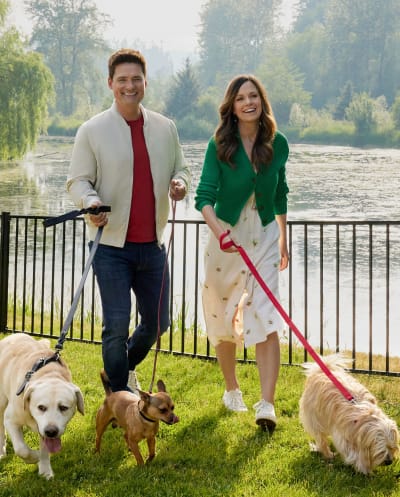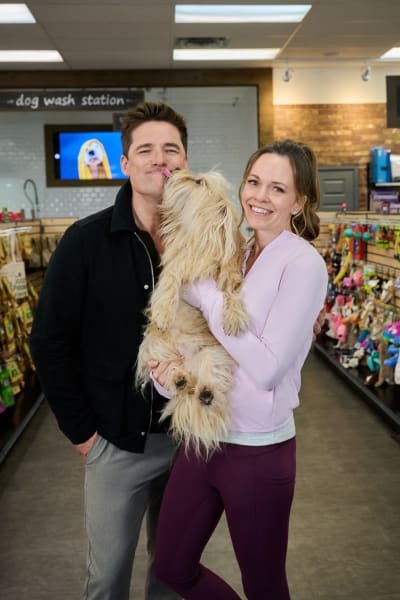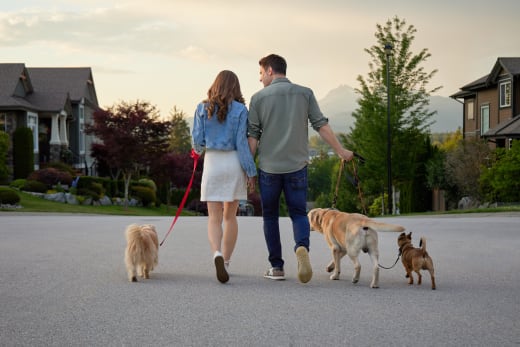The More Love Grows premieres tonight at 9/8c on Hallmark Movies & Mysteries.
The film stars Rachel Boston and Warren Christie as two parents at a crossroads in life who become friends through a lost dog. Their characters grow closer as they are empowered to take their lives in new directions.
We had the chance to chat with The More Love Grows director, Heather Hawthorne Doye, who is currently filming another project for the network, and she shared her insights into bringing this emotional story to life.
The More Love Grows is delightful. What was your initial vision of the writer’s work?
Okay, you know, what I loved about reading this script? Is it hit on all three things that I look for, which is how’s it gonna look visually? What kind of actors are we going to be able to put in these roles? And does it move me emotionally?
I love a multigenerational story. And the fact that it’s a woman who’s going through some interesting times, some shocking things are happening to her. She’s reclaiming her strength, all while repairing a relationship with her mom and being a role model to her daughter. It’s so great to do these multigenerational stories.
And what was your source of inspiration for directing the movie?
It’s funny, when I think about things like this, I say to myself, who do I know in these roles? Who have I been with it? Does this hit me? So definitely, my relationship with my mom hit me there for sure.
And there were even a few tweaks we did in the writing to go okay, this is really from my heart, Rachel Boston, who is our incredible lead in this movie, she’s been going through some stuff. And so she was able to bring out real truthfulness and honesty.
And when you’re partnered up with a lead actress like that, it really helps you as a director help to motivate something that’s extra special, which this definitely was. And I have sons; they’re men now. But just that moment when you send your child off to college, and what that feels like, was very similar.
What’s really funny, too, is our executive from Hallmark. Aisha Francis, her daughter, just graduated from university. So we all had these moments that we were bringing to the film from our own life.
Oh, that’s wonderful. It’s a lot of non-film-related influences, then, that crafted the movie.
Yes, very much so. And I love to laugh. So I want to feel things deeply, but I also want to laugh.
So when I found that there was a dog in the movie, and a dog who gets the most kisses, I’m just going to spoil that now — the dog gets a lot of kissing.
I love the relationships she ends up with, with the dog, and how that worked out. And I really do love working with animals, so that was an extra bonus for me to do a fun dog movie, too.
And how does directing a movie change whenever you’re incorporating not only people’s performances but animals’ as well?
That is such a great question. So you have to do things differently when there’s an animal and set. So I’ll give you a little bit of like inside talk on that. When there’s an animal on set, we usually will try to shoot our wider shots and a close-up of the animal at the same time.
So I’m shooting a wide shot of the scene, maybe not the super biggest shot ever. But, like a nice shot, that group that shows all the characters, and then I’m tight on the animal. Then after that, I shoot above the animal so that the animal is not in the shot, but they know what the animal has done.
And so that way, you don’t have to try to get a dog to look exactly a certain way at the same time, which is too hard to do, to be clear. So yeah, that’s really what you do. And this dog and our trainer were fantastic.
I like how you put that. Because I was wondering, too, is it hard to elicit emotions from actors when they’re working in a dog’s performance, too?
You’re so smart. So what’s tough is, and the first thing I say to the team, all the actors and stuff like that, is you know your lines, you know the intention behind the line, but act and react with the dog, like if the dog does something funny go for it.
So when are the characters, Warren Christie — and let’s just say how great Warren Christie and Rachel Boston are — has a fantastic time with his two dogs there. She doesn’t even have her dog yet. He’s got his two dogs, and it just makes for a really warm, beautiful, unbelievable scene.
Yeah, I imagine that they have to work off of them as much as the dogs work off of the people.
One hundred percent. And we had so many. We totally had four dogs, a cat, a hamster, and a turtle in this movie. And here’s a game you can play. Spot the turtle because you really almost can’t spot the turtle.
I don’t remember a turtle. Now I feel like I have to watch it again to figure it out!
And the turtle did not get a closeup, to be clear.
You just mentioned this a little bit, but what kind of experiments do you do with like unique camera movements and compositions that you find to be helpful? I mean, you shared how you do it with the dog. What are your other secrets?
Yeah, that’s great. So it’s fun each time to go, “What’s the meaning behind the scene?” So I always try to make the meaning behind this scene to be the first thing. So if you go story first, that will help you determine what your visuals are.
So sometimes I wanted to be frenetic. And I want people to be moving in and out. And so we’ll do it that way. And other times, I want it to be very still so that we really hear and see their eyes and what they’re doing.
And so, even the opening of the movie, we’ve got a little bit of moving around of people because I want that to be sort of a bigger thing. And then I don’t want to give this one away too much.
But one of my favorite scenes to shoot in the movie was when her mom comes over to, let’s say, confront her about some of the things that are going on in her life. And perhaps we had the opportunity to shoot that in multiple areas in the house. So that was my favorite scene to shoot. It was so fun.
And what’s your strategy for making sure that every character’s perspective is seen and visually represented in a scene when they all have something emotional going on?
Yeah, that’s cool. So one of the things I do after a movie airs to just sort of like double-check myself and see how I’ve done is all watch the movie without the sound. I want to be able to see what are the faces like? What are the shots? Like, is this telling the story, even if you couldn’t hear the words?
And so that has helped me really hone in on actions and reactions from our characters, too. So say to them right from the beginning, just so y’all know, I want to be on the person listening to the conversation, at least as much as I want to be on the person having the conversation.
And obviously, I’m not going to cut away a whole bunch of times. Like if someone’s having a really good conversation, they’re saying really important words, I’m gonna stay on them. But I love faces.
And I love the reaction of the face in the story, and Gabrielle Rose, who played the mom, oh, my gosh, Gabrielle is someone I’ve wanted to work with forever. She’s sort of like Canadian royalty in acting and stuff like that. It was so great having her play the mom and just seeing her face.
Yes, she has a lot of good facial expressions. You can read what she’s thinking. Whatever you did, it worked.
Well, and I’ve got to give her a lot of credit or all the credit.
What’s fun for me, as a director, is I always say when I have a chance to work with actors, and they’ll give a performance, and I’ll give a suggestion, and then they do something so much better than what I suggested.
You can see me at the monitors, like when I’m watching it, I’m like, you know, waving my little Apple pen going, “Yes, this is gorgeous.” And there was a lot of that in this movie. It was emotional.
There are some beautiful performances by Rachel, Warren, Roan [Curtis], who played her daughter, Gabrielle, and Lynda Boyd, of course, there are some great performances in this movie.
So how do you foster a collaborative atmosphere like that? Do you give them upfront permission to share what they think? Or how do you do that?
Yeah, super smart question. So I start by saying the first take every time is yours. I’m not going to give you direction before I have a chance to see what you and your castmates worked so hard preparing for that scene.
So I’m always going to have you offer up what you feel is the best thing that you can do at that scene. And then the chances are, I’m going to give us a check for take two because I got what you didn’t take one. Now, let me see if we can nuance it a little bit.
And sometimes we’ll try something, and maybe it’ll work, and maybe it doesn’t work. But it’s like, let’s try something else. Let’s see what else we can get.
And you usually know something works while you’re filming it? Or does that also change after the fact?
I would say 97% of the time, I know if something works while I’m filming it. Only once in a blue moon, and to my surprise, it’s because I’ve spent a lot of time in the edit suite. So for me, I’m editing in my head all the time. I’m looking at it, and nobody has to do a whole take perfectly.
But between a couple of takes, I need everything to sort of work out and be the right emotion and stuff. And that’s what we get.
So I don’t like to move on until I know that we’ve gotten what is going to serve the character the best and serve the story. It’s all about telling stories to entertain people and make them feel something.
Are there any particular instances on this where you were just so surprised by what somebody put out there, and it exceeded your expectations?
Yes, Patrick [Gilmore], and who plays the husband, let’s say, Patrick and Rachel are doing the scene with the mediator.
What they gave when they took that little break from the mediation and went out into the hallway, that scene for me was so beautiful, and they gave so much.
And we knew right away as we were shooting it, we knew that we had something special right there.
The whole cast is actually very good, not just the leads, like you said, the daughter, but Patrick, who plays the husband as well. I like every single person in this movie. You had such a great cast.
Yes, thank you very much. I think we were blessed to do that. And part of that, too, was that our executive producer, John Cassini is also an actor and has been in Vancouver for a long, long time and knows everybody.
So take, for example, I knew right from the beginning that I really wanted Gabrielle Rose to play the mom. And I said that to John, who said, “Oh, I know her super well. Like we were great friends.”
So it’s the combination of a good script and, you know, I think having the chance to work together and then, of course, being with John had Gabrielle saying yes, so quickly.
So how would you say that The More Love Grows stands apart from or complements your previous work?
All right, brilliant. I think, and I said this to our production executive right from the beginning, it’s the really heartfelt emotion. I think it’s something that I’ve really been exploring in my work. And so really getting those true and honest performances are super important.
I think there were some beautiful performances here from every level. And some of that is because we just had such a spectacular cast. And everybody brought something really beautiful. So I think that is really special. I think there are a couple of scenes with the dog that are super fun.
And I’ve done some movies before where a dog has been a co-star. That’s a really hard but wonderful thing to get. So I think that is something that I’ll remember a lot from The More Love Grows. And then I think it’s also just the fact that it told a story of a woman becoming stronger. And that is something I love to put in my work.
I love watching it too. You’re not just a director, but you’re also a consumer of entertainment. So what is it about The More Love Grows that appeals to you on a personal level?
What I love about this movie, and what will make me watch it myself multiple times, still, is that generational storytelling, and it’s also the empowering of women, yet not putting down men. What I love is that the husband goes through a journey and figures things out himself, which is great.
And Warren Christie, the lead male, he also went through some stuff; he’s also becoming stronger. He also is doing something he was always destined to do. But circumstances, when he was younger, meant he didn’t get to do it. It’s living out your dreams.
I’m someone who always wanted to be a mom. That was super important to me. But I also knew I always wanted to do TV and film. And so I decided that, as the kids were little, being their mom was the most important thing to me. So I did television, but I didn’t do this kind of television. I didn’t do these stories.
I did factual television shows for HGTV and stuff, which I loved. But then, as soon as the kids were grown, I was like, I can do anything I want to do, and what I want to do is tell stories that touch people. I want to tell stories that make a difference and stories that make me proud.
And that’s how I got into doing scripted television. And I always knew that I would find a great partner in Hallmark. And I’m thrilled with the movies I’ve been able to tell on the Hallmark channels.
You can watch The More Love Grows tonight on Hallmark Movies & Mysteries at 9/8c.
Carissa Pavlica is the managing editor and a staff writer and critic for TV Fanatic. She’s a member of the Critic’s Choice Association, enjoys mentoring writers, conversing with cats, and passionately discussing the nuances of television and film with anyone who will listen. Follow her on Twitter and email her here at TV Fanatic.
